Study on the Liquid Cooling Method of Longitudinal Flow through Cell Gaps Applied to Cylindrical Close-Packed Battery
Abstract
:1. Introduction
- Improved energy density of cylindrical battery packs
- 2.
- Improved uniform temperature performance of cylindrical battery packs
2. Method and Experiment
2.1. Simulation
2.1.1. Longitudinal-Flow Geometry Model
2.1.2. Model Calculation Domain
2.1.3. Genetic Algorithm
2.1.4. Control Equation and Related Parameters
Heat Generation Mechanism of Battery
Flow and Heat Transfer Equation
2.1.5. Initial and Boundary Conditions
2.1.6. Grid Validity Verification
2.2. Experiment
2.2.1. TDC-Based Pack Principle
TDC Structure
Design of TDC Battery Pack and Liquid-Cooled Heat Exchange Structure
2.2.2. Test System and Method
Test System Composition
Test Procedure
- (1)
- Establish cooling water circulation to bring the flow rate up to the predetermined value.
- (2)
- Start the temperature acquisition system, observe, and wait for the coolant inlet and outlet temperatures to become essentially constant.
- (3)
- Import the predefined output voltage sequence into the programmable power supply.
- (4)
- Clear the temperature acquisition system’s historical data and start a new acquisition while starting the power supply output.
- (5)
- Wait for the programmable power supply to complete the voltage sequence output, and then end the temperature sampling and save the data.
3. Results
3.1. Analysis of Simulation Results
3.1.1. Comparison of Cooling Performance with Transverse-Flow Battery Pack
3.1.2. Effect of Flow Channel Parameters on Thermal Performance of Longitudinal Flow Battery Pack
3.1.3. Effect of Operating Parameters on the Thermal Performance of Longitudinal-Flow Battery Packs
- (1)
- Influence of coolant flow change on cooling effect
- (2)
- Influence of discharge rate on cooling effect of battery pack
3.1.4. Functional Verification in High-Temperature Environment
3.2. Analysis of Experimental Results
3.2.1. Test Results and Analysis under Constant Condition
- (1)
- The average temperature performance of a battery pack at a high discharge rate
- (2)
- Effect of coolant flow rate on heat dissipation performance of longitudinal-flow battery pack
3.2.2. Test Results and Analysis under NEDC Conditions
4. Discussion
5. Conclusions
Author Contributions
Funding
Data Availability Statement
Conflicts of Interest
References
- Kaya, K.; Hames, Y. Two New Control Strategies: For Hydrogen Fuel Saving and Extend the Life Cycle in the Hydrogen Fuel Cell Vehicles. Int. J. Hydrogen Energy 2019, 44, 18967–18980. [Google Scholar] [CrossRef]
- Wang, H.; Xu, W.; Ma, L. Actively Controlled Thermal Management of Prismatic Li-Ion Cells under Elevated Temperatures. Int. J. Heat Mass Transf. 2016, 102, 315–322. [Google Scholar] [CrossRef]
- Karimi, G.; Li, X. Thermal Management of Lithium-Ion Batteries for Electric Vehicles. Int. J. Energy Res. 2013, 37, 13–24. [Google Scholar] [CrossRef]
- SAE MOBILUS. Available online: https://saemobilus.sae.org/content/2011-01-2249/ (accessed on 26 July 2023).
- Kang, D.; Lee, P.-Y.; Yoo, K.; Kim, J. Internal Thermal Network Model-Based Inner Temperature Distribution of High-Power Lithium-Ion Battery Packs with Different Shapes for Thermal Management. J. Energy Storage 2020, 27, 101017. [Google Scholar] [CrossRef]
- Asensio, F.J.; San Martin, J.I.; Zamora, I.; Onederra, O. Model for Optimal Management of the Cooling System of a Fuel Cell-Based Combined Heat and Power System for Developing Optimization Control Strategies. Appl. Energy 2018, 211, 413–430. [Google Scholar] [CrossRef]
- Fang, G.; Yuan, W.; Yan, Z.; Sun, Y.; Tang, Y. Thermal Management Integrated with Three-Dimensional Heat Pipes for Air-Cooled Permanent Magnet Synchronous Motor. Appl. Therm. Eng. 2019, 152, 594–604. [Google Scholar] [CrossRef]
- Guo, F.; Zhang, C. Oil-Cooling Method of the Permanent Magnet Synchronous Motor for Electric Vehicle. Energies 2019, 12, 2984. [Google Scholar] [CrossRef] [Green Version]
- Hu, X.; Li, S.; Peng, H. A Comparative Study of Equivalent Circuit Models for Li-Ion Batteries. J. Power Sources 2012, 198, 359–367. [Google Scholar] [CrossRef]
- Pesaran, A.A.; Burch, S.; Keyser, M. An Approach for Designing Thermal Management Systems for Electric and Hybrid Vehicle Battery Packs. In Proceedings of the VTMS 4: Vehicle Thermal Management Systems; Professional Engineering Publishing Ltd.: Westminister, UK, 1999; pp. 331–346. [Google Scholar]
- Kumar Thakur, A.; Sathyamurthy, R.; Velraj, R.; Saidur, R.; Pandey, A.K.; Ma, Z.; Singh, P.; Hazra, S.K.; Wafa Sharshir, S.; Prabakaran, R.; et al. A State-of-the Art Review on Advancing Battery Thermal Management Systems for Fast-Charging. Appl. Therm. Eng. 2023, 226, 120303. [Google Scholar] [CrossRef]
- Qin, P.; Sun, J.; Yang, X.; Wang, Q. Battery Thermal Management System Based on the Forced-Air Convection: A Review. eTransportation 2021, 7, 100097. [Google Scholar] [CrossRef]
- Zhao, G.; Wang, X.; Negnevitsky, M.; Li, C. An Up-to-Date Review on the Design Improvement and Optimization of the Liquid-Cooling Battery Thermal Management System for Electric Vehicles. Appl. Therm. Eng. 2023, 219, 119626. [Google Scholar] [CrossRef]
- Thawkar, V.; Dhoble, A.S. A Review of Thermal Management Methods for Electric Vehicle Batteries Based on Heat Pipes and PCM. J. Braz. Soc. Mech. Sci. Eng. 2023, 45, 90. [Google Scholar] [CrossRef]
- Rehman, T.; Ambreen, T.; Niyas, H.; Kanti, P.; Ali, H.M.; Park, C.-W. Experimental Investigation on the Performance of RT-44HC-Nickel Foam-Based Heat Sinks for Thermal Management of Electronic Gadgets. Int. J. Heat Mass Transf. 2022, 188, 122591. [Google Scholar] [CrossRef]
- Lamba, R.; Montero, F.J.; Rehman, T.; Singh, S.; Manikandan, S. PCM-Based Hybrid Thermal Management System for Photovoltaic Modules: A Comparative Analysis. Environ. Sci. Pollut. Res. 2023. [Google Scholar] [CrossRef]
- Rehman, T.; Ali, H.M. Thermal Performance Analysis of Metallic Foam-Based Heat Sinks Embedded with RT-54HC Paraffin: An Experimental Investigation for Electronic Cooling. J. Therm. Anal. Calorim. 2020, 140, 979–990. [Google Scholar] [CrossRef]
- Allafi, W.; Zhang, C.; Uddin, K.; Worwood, D.; Dinh, T.Q.; Ormeno, P.A.; Li, K.; Marco, J. A Lumped Thermal Model of Lithium-Ion Battery Cells Considering Radiative Heat Transfer. Appl. Therm. Eng. 2018, 143, 472–481. [Google Scholar] [CrossRef] [Green Version]
- Wang, G. Modeling of Heat Dissipation and Cooling in Thermal Management Systems and Control Strategies for Battery Pack Temperature Equalization. Ph.D. Thesis, Jilin University, Changchun, China, 2017. (In Chinese). [Google Scholar]
- Chen, D.; Jiang, J.; Kim, G.-H.; Yang, C.; Pesaran, A. Comparison of Different Cooling Methods for Lithium Ion Battery Cells. Appl. Therm. Eng. 2016, 94, 846–854. [Google Scholar] [CrossRef] [Green Version]
- Zhou, H.; Zhou, F.; Xu, L.; Kong, J.; Yang, Q. Thermal Performance of Cylindrical Lithium-Ion Battery Thermal Management System Based on Air Distribution Pipe. Int. J. Heat Mass Transf. 2019, 131, 984–998. [Google Scholar] [CrossRef]
- Test and Analysis of OCV Temperature Coefficient of Lithium-Ion Batteries- All database. Available online: https://www.webofscience.com/wos/alldb/full-record/CSCD:5001074 (accessed on 26 July 2023).
- Fundamentals of Thermal Engineering and Fluid Mechanics_Book Search. Available online: https://book.duxiu.com/bookDetail.jsp?dxNumber=000008310732&d=4BFE8B2559EAD7C5E8093BCCD7FDA9F3&fenlei=130208&sw=%E7%83%AD%E5%B7%A5%E5%9F%BA%E7%A1%80%E5%8F%8A%E6%B5%81%E4%BD%93%E5%8A%9B%E5%AD%A6 (accessed on 26 July 2023). (In Chinese).
- Bigdeli, M.B.; Fasano, M.; Cardellini, A.; Chiavazzo, E.; Asinari, P. A Review on the Heat and Mass Transfer Phenomena in Nanofluid Coolants with Special Focus on Automotive Applications. Renew. Sustain. Energy Rev. 2016, 60, 1615–1633. [Google Scholar] [CrossRef] [Green Version]
- Kalaf, O.; Solyali, D.; Asmael, M.; Zeeshan, Q.; Safaei, B.; Askir, A. Experimental and Simulation Study of Liquid Coolant Battery Thermal Management System for Electric Vehicles: A Review. Int. J. Energy Res. 2021, 45, 6495–6517. [Google Scholar] [CrossRef]
- Mondal, B.; Lopez, C.F.; Mukherjee, P.P. Exploring the Efficacy of Nanofluids for Lithium-Ion Battery Thermal Management. Int. J. Heat Mass Transf. 2017, 112, 779–794. [Google Scholar] [CrossRef]
- Li, W.; Xiong, S.; Zhou, X.; Shi, W.; Wang, C.; Lin, X.; Cheng, J. Design of Cylindrical Thermal Dummy Cell for Development of Lithium-Ion Battery Thermal Management System. Energies 2021, 14, 1357. [Google Scholar] [CrossRef]
- Li, W.; Xiong, S.; Zhou, X.; Shi, W. Design of a Multichannel Dynamic Temperature Measurement System ForDeveloping Thermal Management System of New Energy Vehicles. Energy Eng. 2020, 117, 301–314. [Google Scholar] [CrossRef]
- An, Z. A Study of LiFePO_4 Battery Cooling and Thermal Safety Based on Flow Boiling. Ph.D. Thesis, Beijing Jiaotong University, Beijing, China, 2019. (In Chinese). [Google Scholar]
- Lin, P.-Y. Some issues on infrared thermometers. Sci. Technol. Outlook 2015, 25, 181. (In Chinese) [Google Scholar]


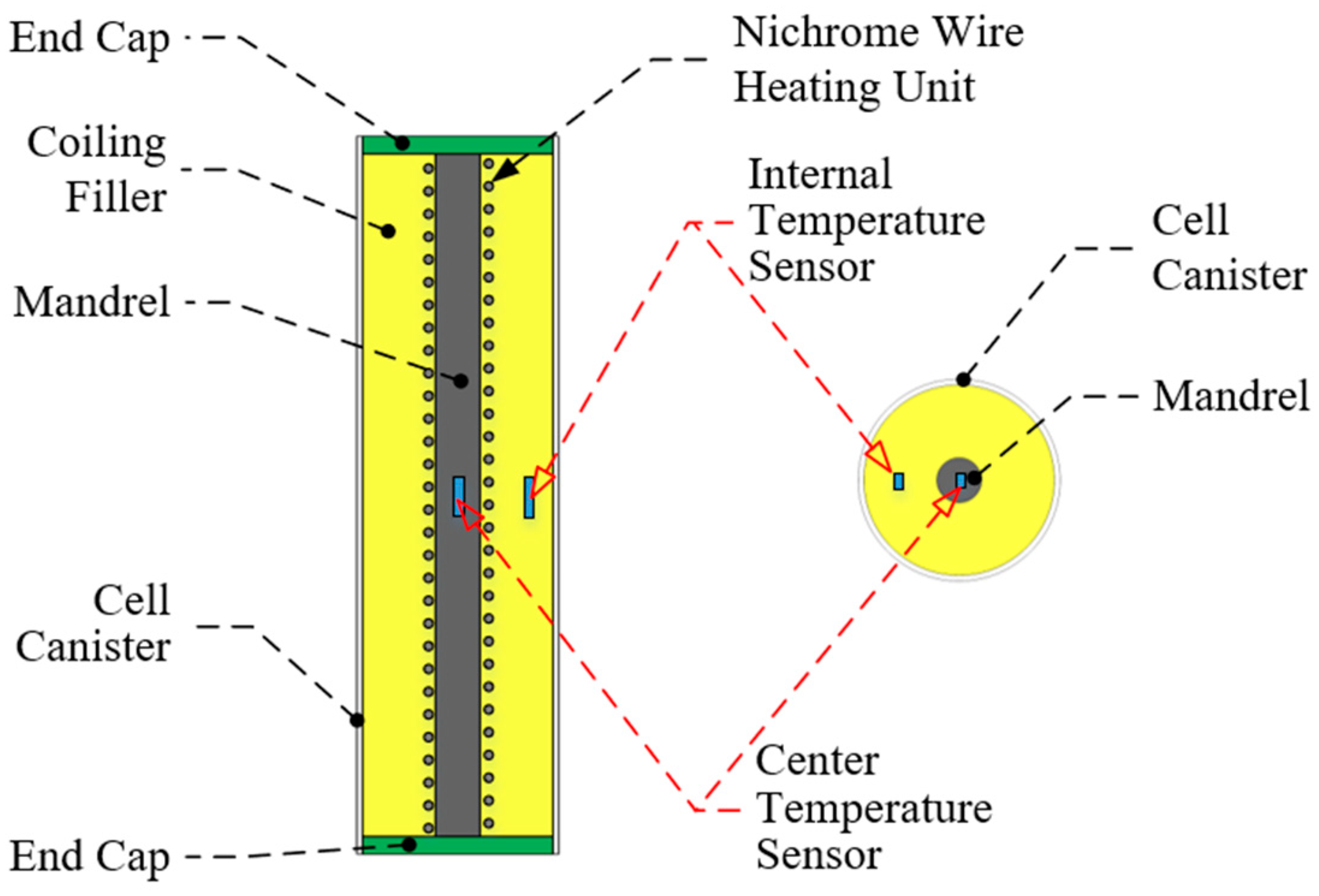
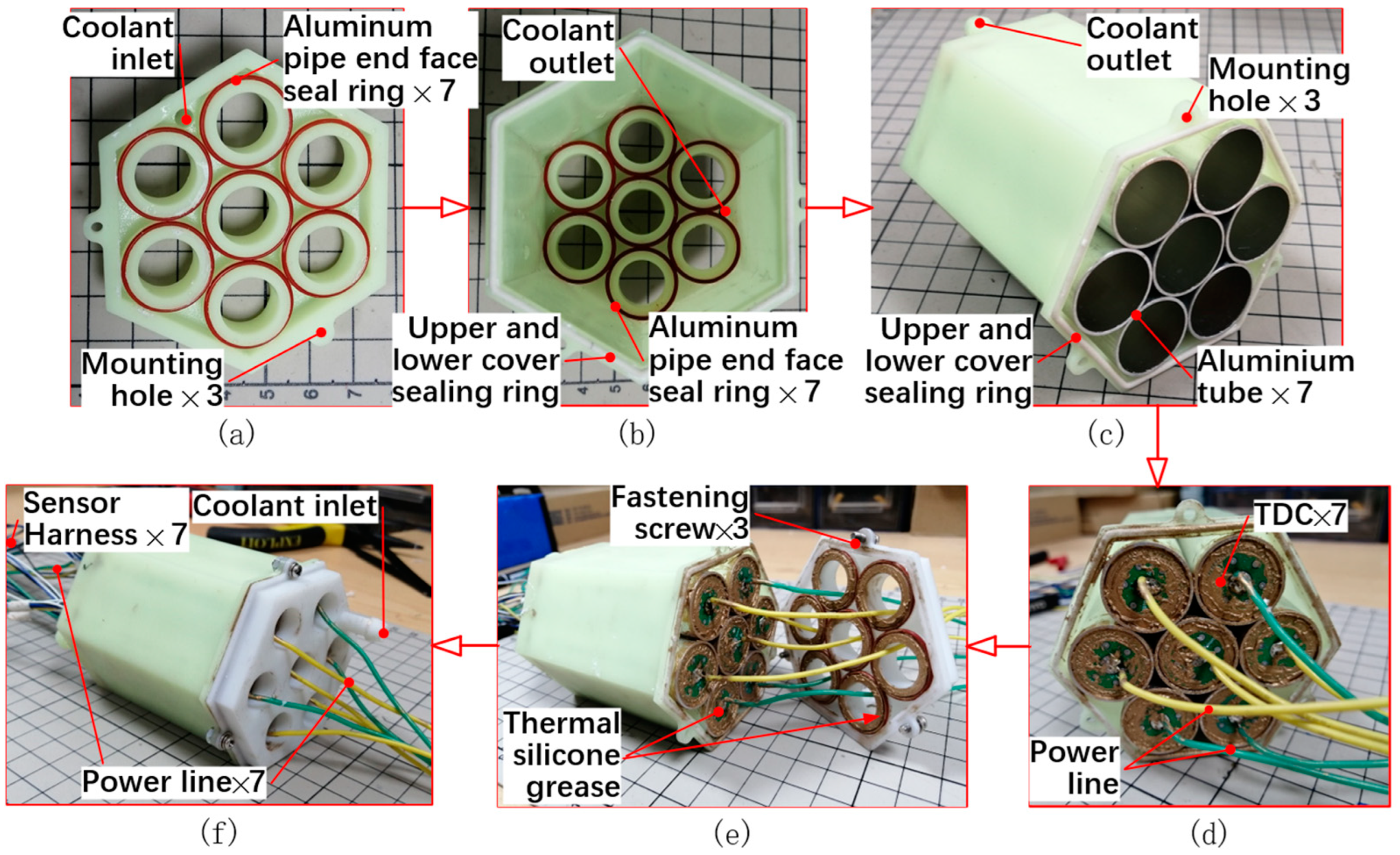


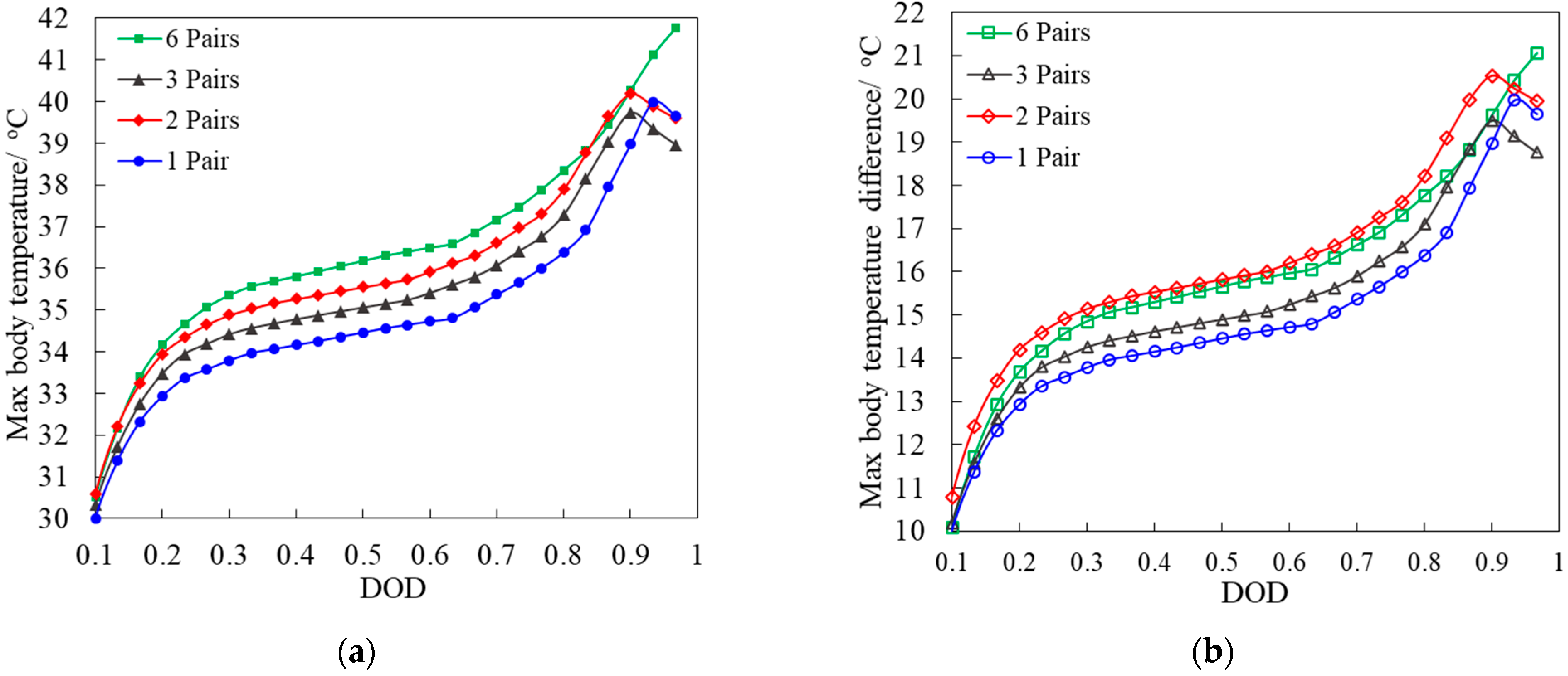
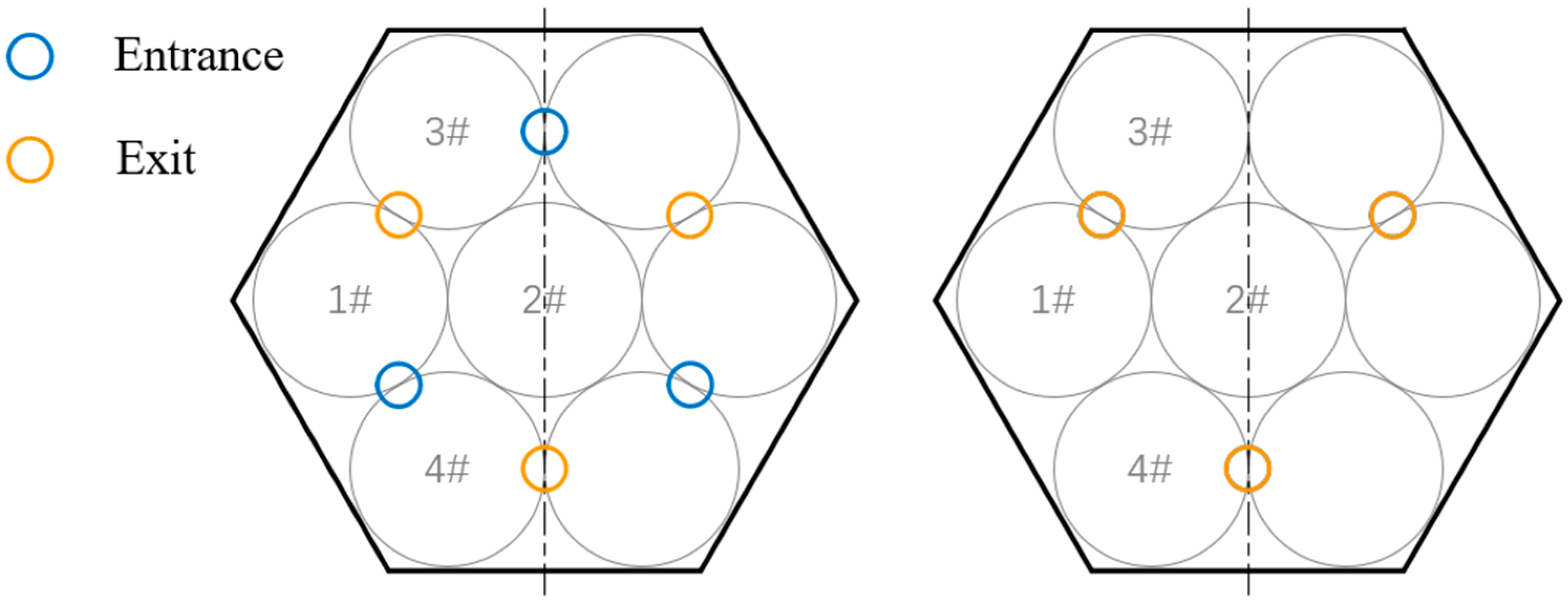
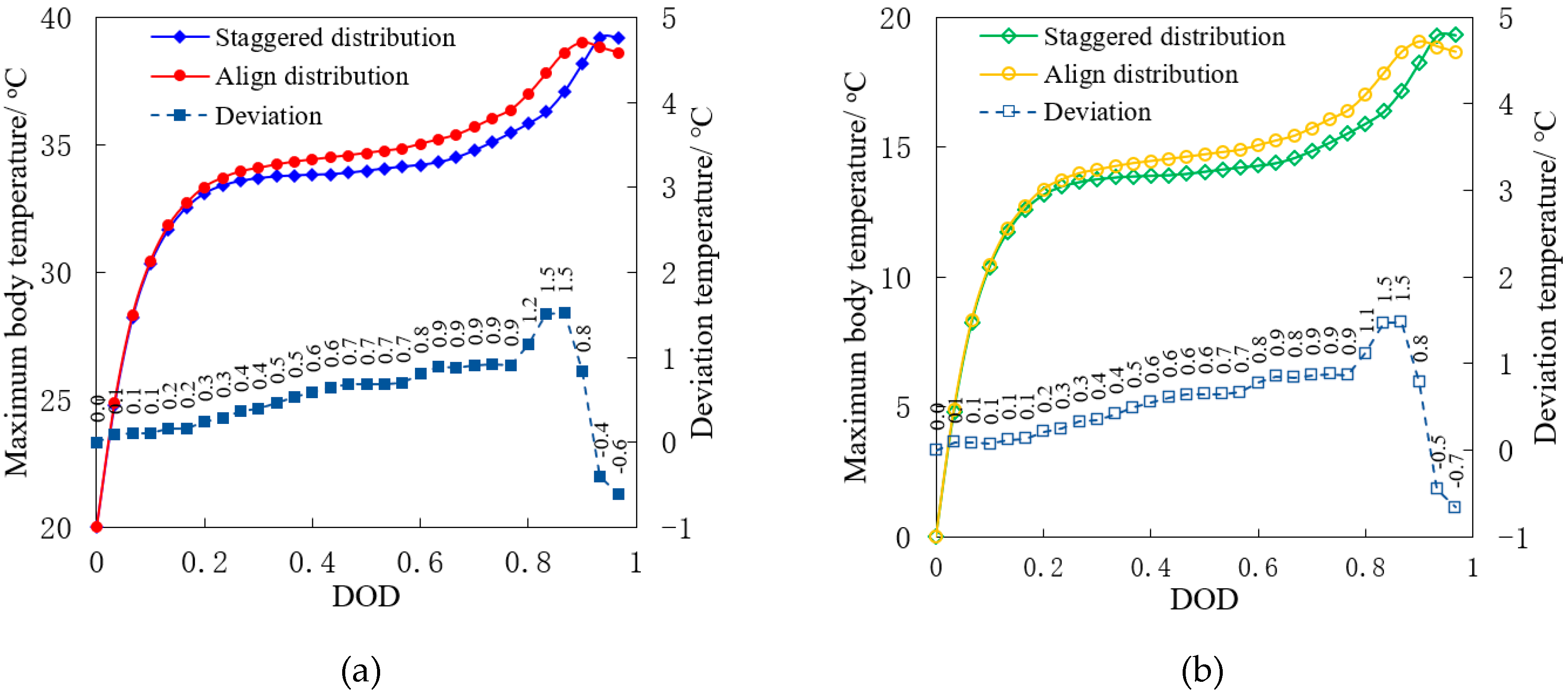

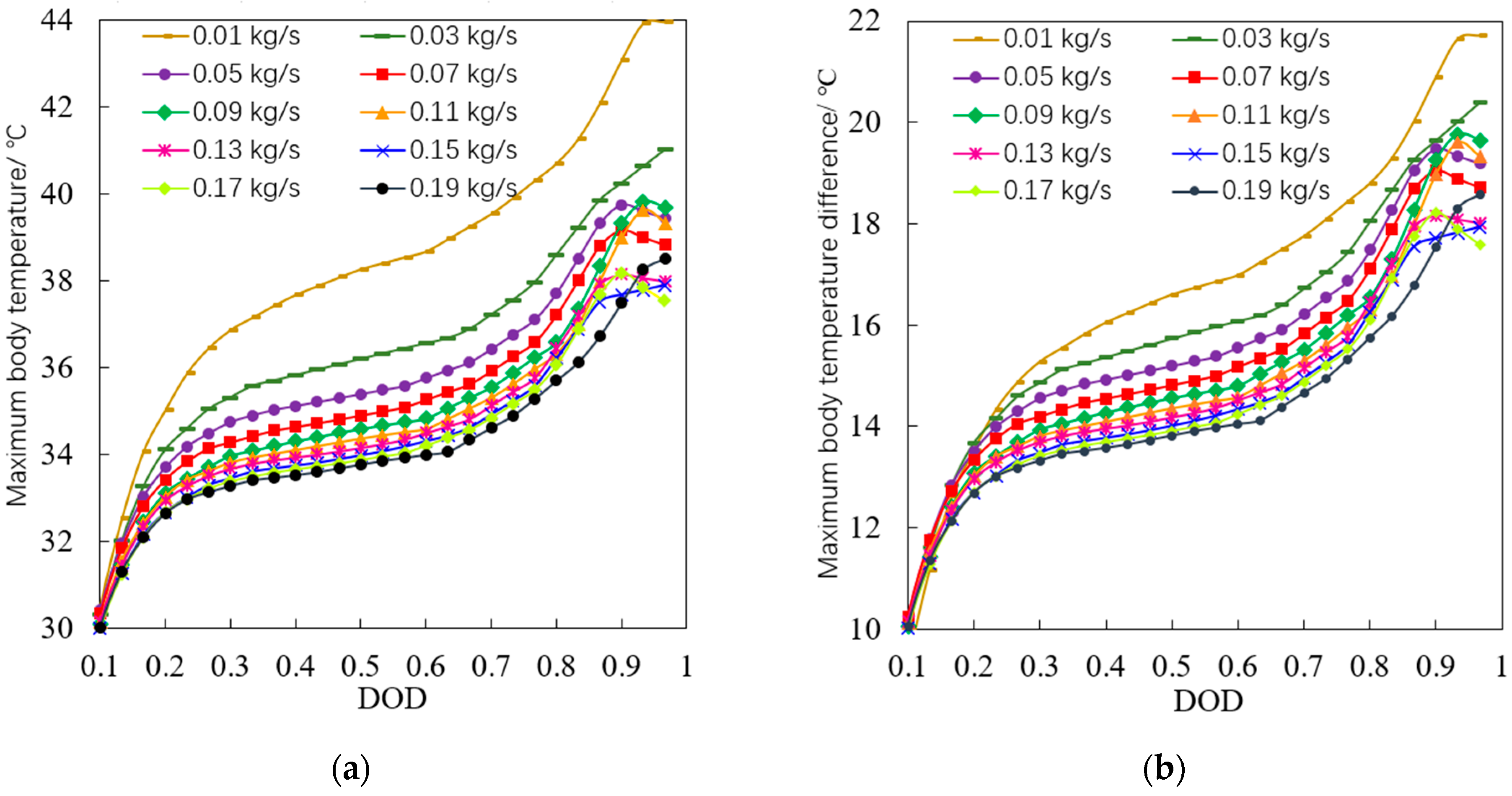
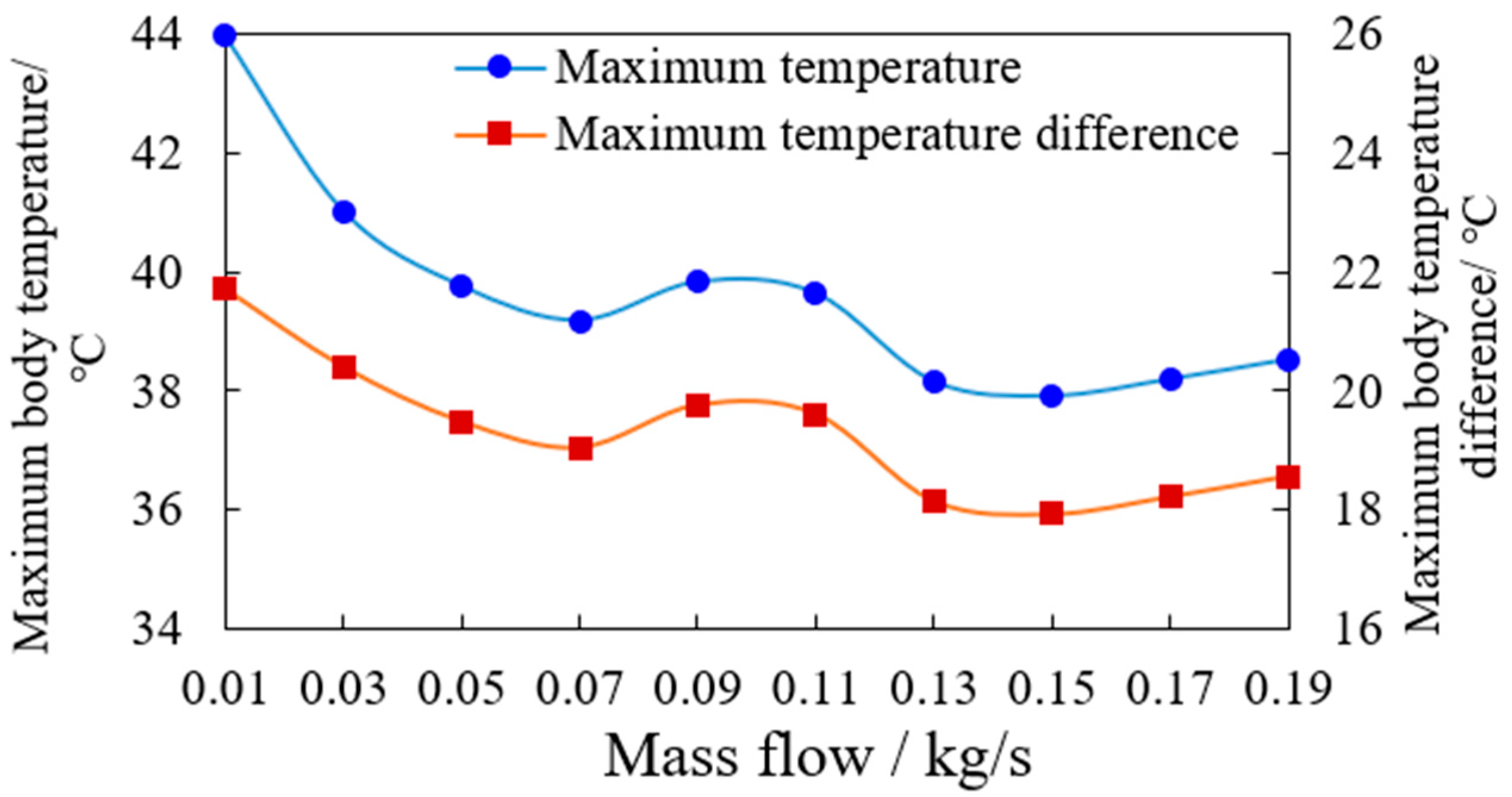

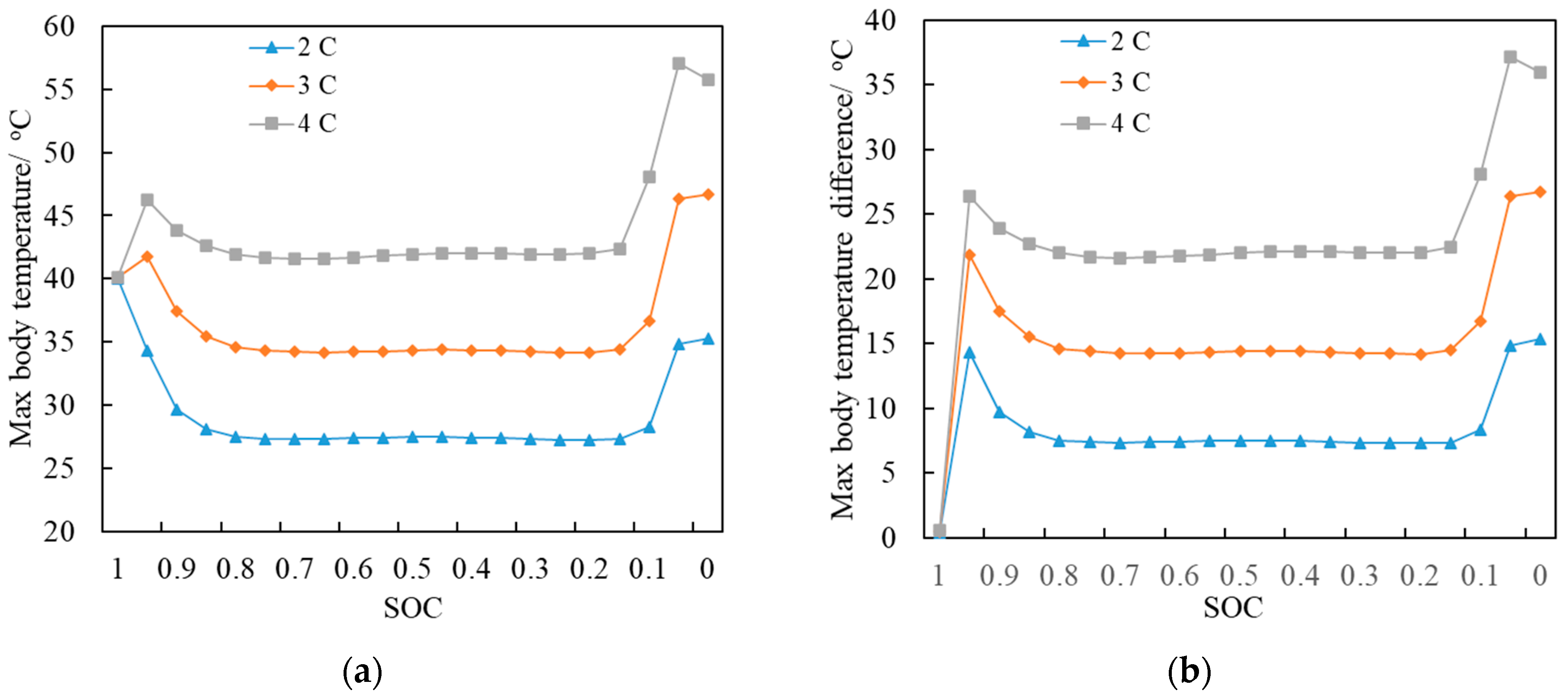

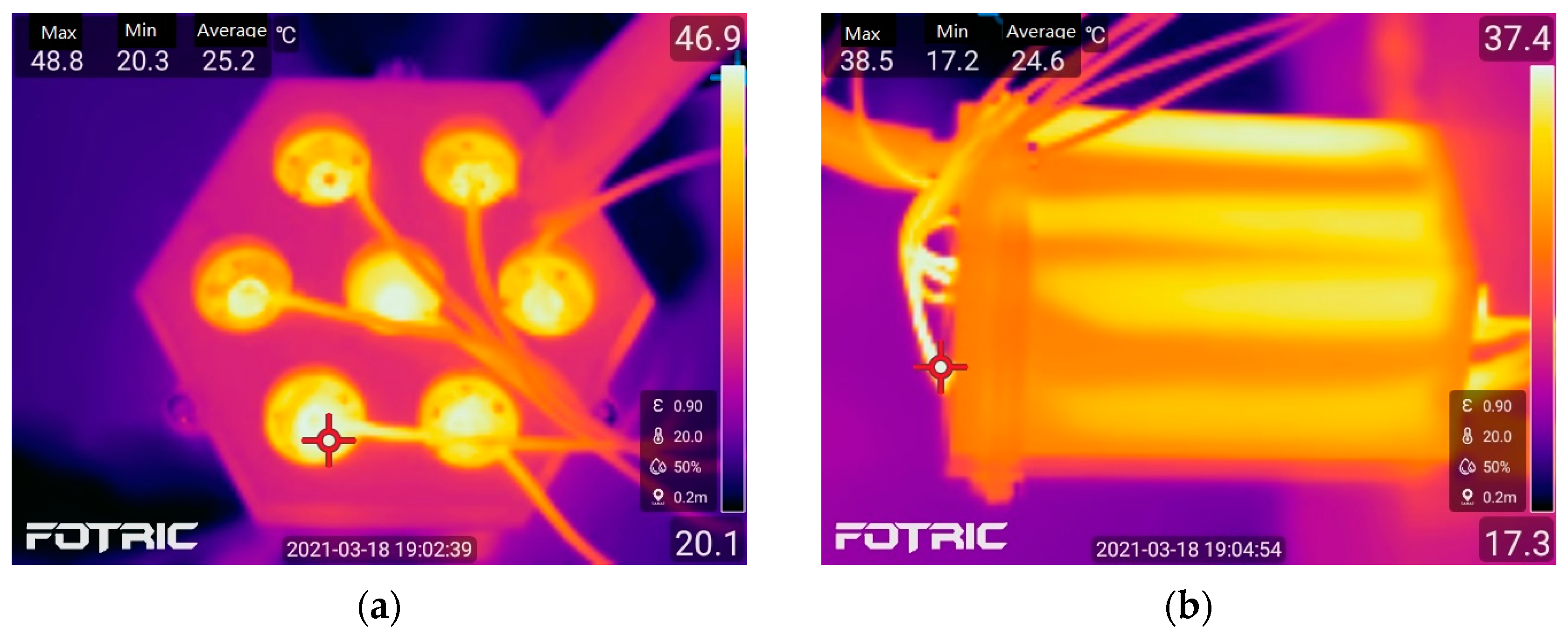
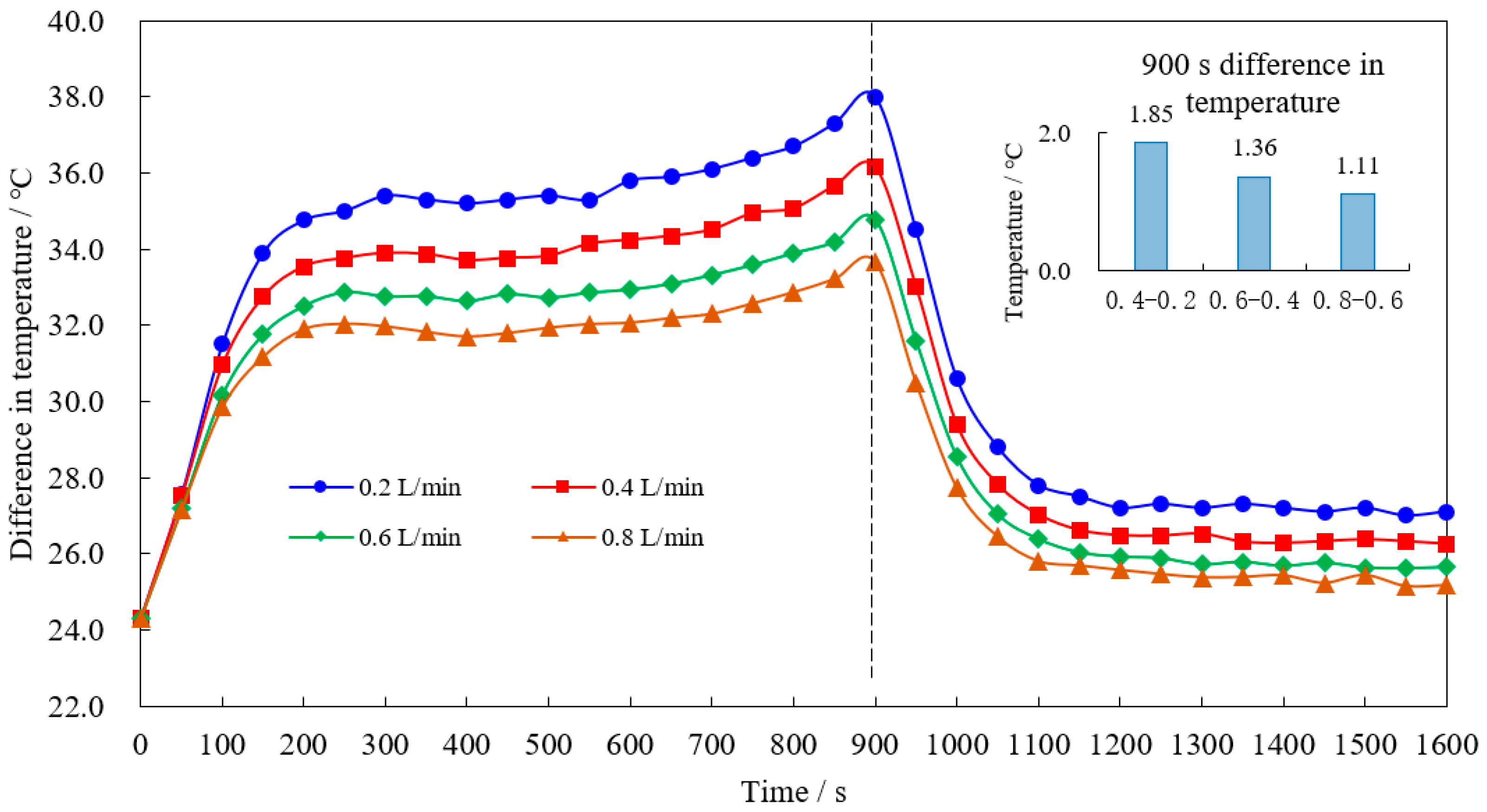
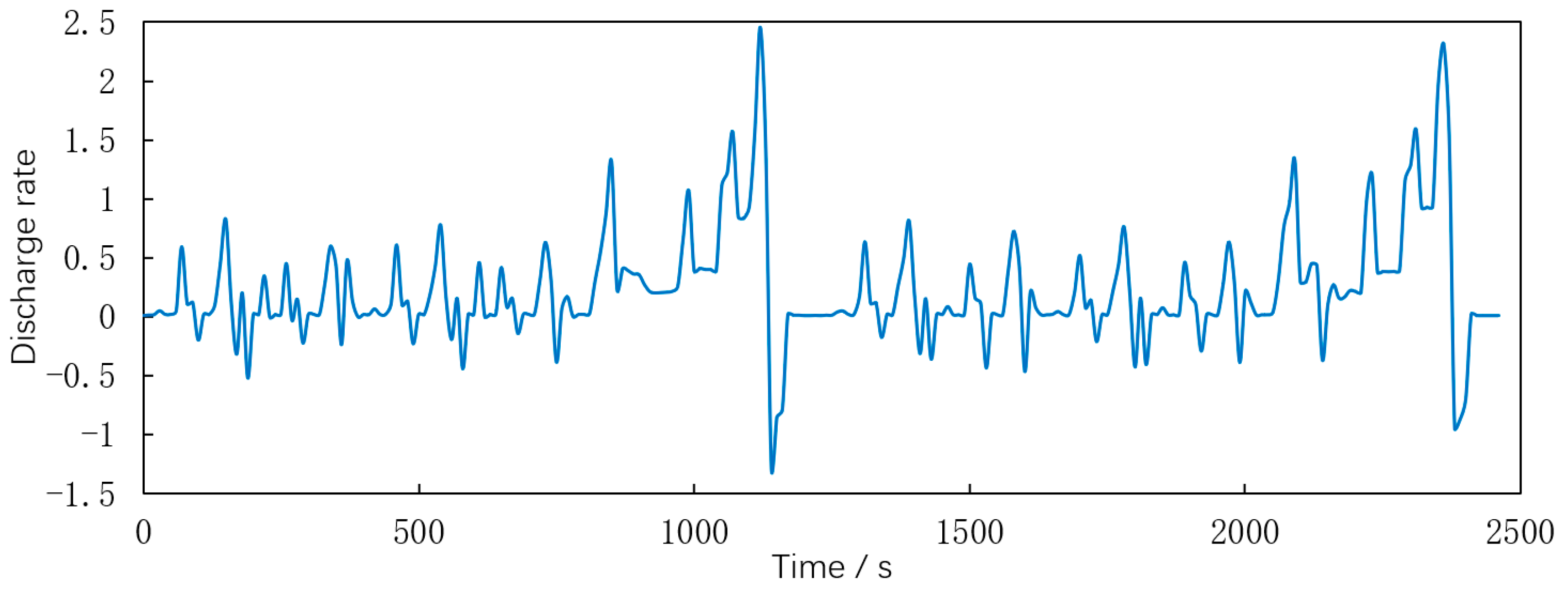

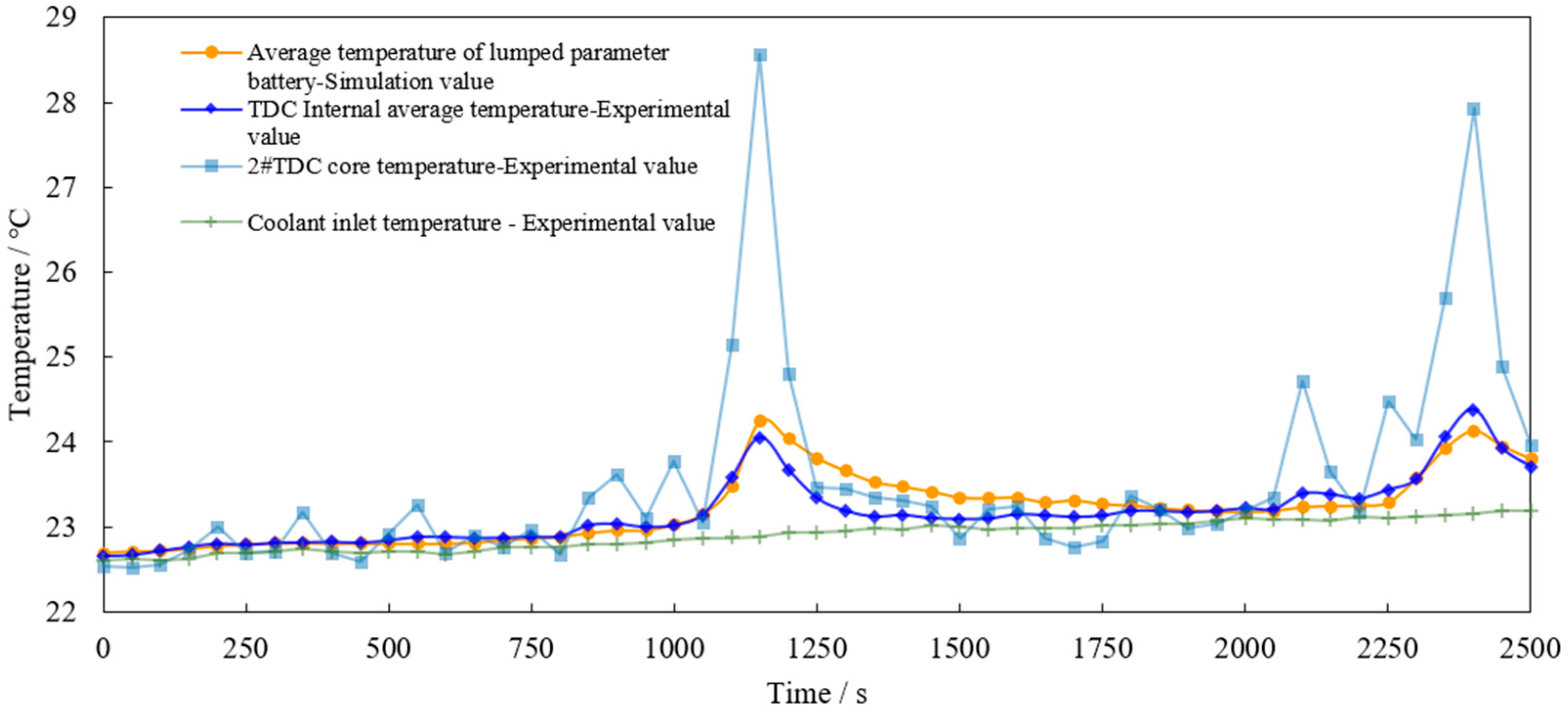
| Number | Conditions |
|---|---|
| 1 | The initial temperature and reference temperature of the model and environment are set as 20 °C |
| 2 | The outer wall of the water jacket in contact with the air is set as an adiabatic surface |
| 3 | The heat convection between the two end surfaces of the cell and the heat conduction of the wires are set to a constant heat flux value |
| 4 | The contact thermal resistance of the battery sidewalls and coolant water jacket is ignored |
| 5 | The thermal property parameters of the materials used are treated as constant values |
| 6 | The coolant is set as water, the fluid is considered incompressible, and the gravity of water is ignored |
| 7 | The fluid inlet is set according to the normal inflow speed, and the outlet is set to zero pressure |
| Condition | Value | Unit |
|---|---|---|
| Initial temperature | 20.0 | °C |
| Equivalent heat flux of battery end face | 247.19 | W/(m2K) |
| Radial thermal conductivity of battery | 2.37 | W/(mK) |
| Axial thermal conductivity of battery | 28.27 | W/(mK) |
| Battery capacity | 3.25 | Ah |
| Specific heat capacity of battery at constant pressure | 2482.3 | J/(kgK) |
| Battery density | 2841.60 | kg/m3 |
| Condition | Grid 1 | Grid 2 | Grid 3 | Grid 4 | Grid 5 | Grid 6 |
|---|---|---|---|---|---|---|
| Predefined mode | Super coarsening | Relatively coarsening | Coarsening | Conventional | Refinement | Relative refinement |
| Number of domain units | 42,756 | 73,005 | 123,990 | 229,310 | 612,397 | 1,310,894 |
| Number of boundary elements | 8025 | 12,066 | 17,408 | 25,652 | 46,129 | 71,452 |
| Number of side cells | 1314 | 1663 | 2081 | 2532 | 3673 | 4598 |
| TDC No. | 1 | 2 | 3 | 4 | 5 | 6 | 7 |
|---|---|---|---|---|---|---|---|
| Resistance value/Ω | 14.74 | 14.84 | 14.32 | 14.87 | 14.60 | 14.53 | 14.86 |
| Average value of resistance/Ω | 14.68 | ||||||
Disclaimer/Publisher’s Note: The statements, opinions and data contained in all publications are solely those of the individual author(s) and contributor(s) and not of MDPI and/or the editor(s). MDPI and/or the editor(s) disclaim responsibility for any injury to people or property resulting from any ideas, methods, instructions or products referred to in the content. |
© 2023 by the authors. Licensee MDPI, Basel, Switzerland. This article is an open access article distributed under the terms and conditions of the Creative Commons Attribution (CC BY) license (https://creativecommons.org/licenses/by/4.0/).
Share and Cite
Li, W.; Shi, W.; Xiong, S.; Huang, H.; Chen, G. Study on the Liquid Cooling Method of Longitudinal Flow through Cell Gaps Applied to Cylindrical Close-Packed Battery. Inventions 2023, 8, 100. https://doi.org/10.3390/inventions8040100
Li W, Shi W, Xiong S, Huang H, Chen G. Study on the Liquid Cooling Method of Longitudinal Flow through Cell Gaps Applied to Cylindrical Close-Packed Battery. Inventions. 2023; 8(4):100. https://doi.org/10.3390/inventions8040100
Chicago/Turabian StyleLi, Wei, Wei Shi, Shusheng Xiong, Hai Huang, and Guodong Chen. 2023. "Study on the Liquid Cooling Method of Longitudinal Flow through Cell Gaps Applied to Cylindrical Close-Packed Battery" Inventions 8, no. 4: 100. https://doi.org/10.3390/inventions8040100





